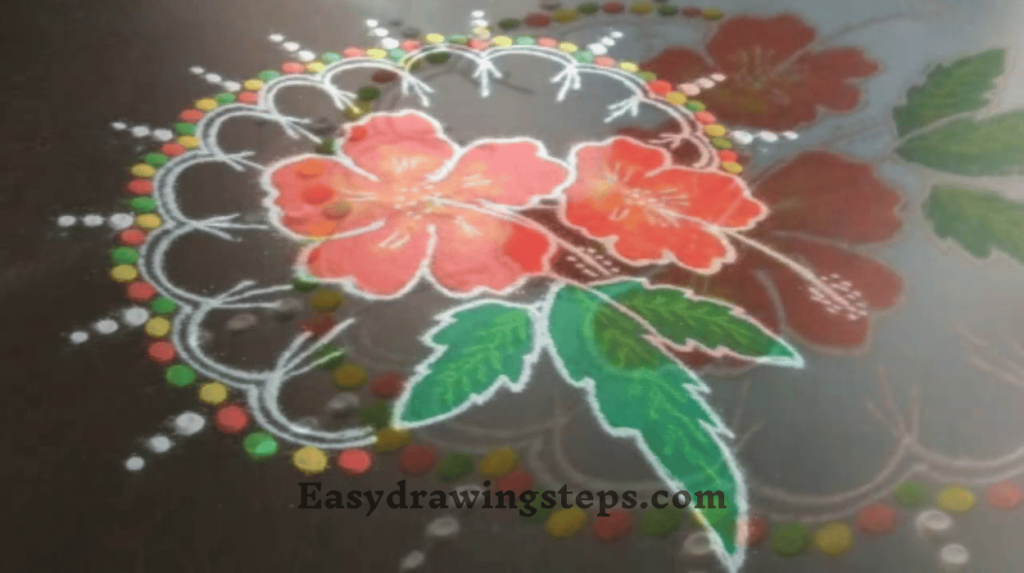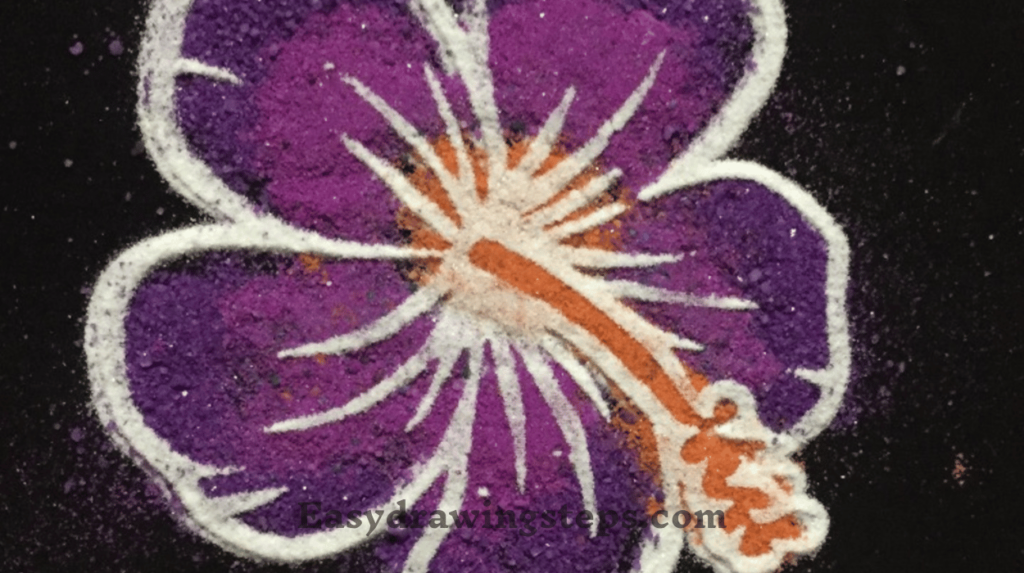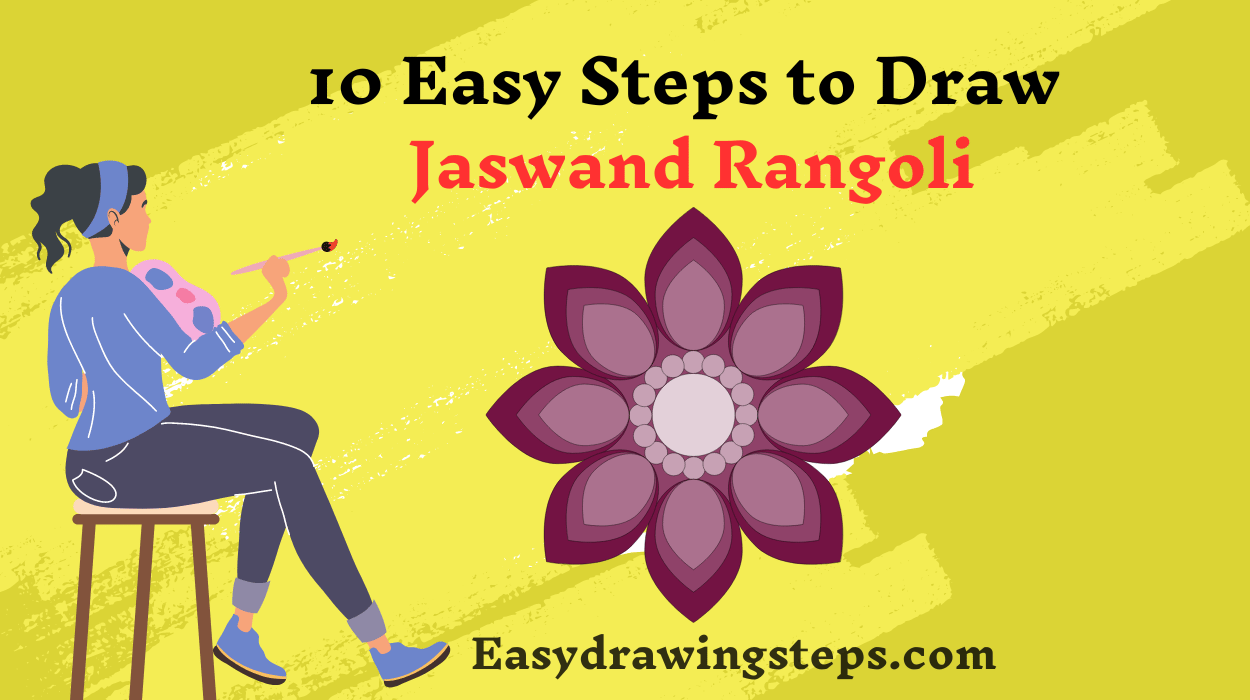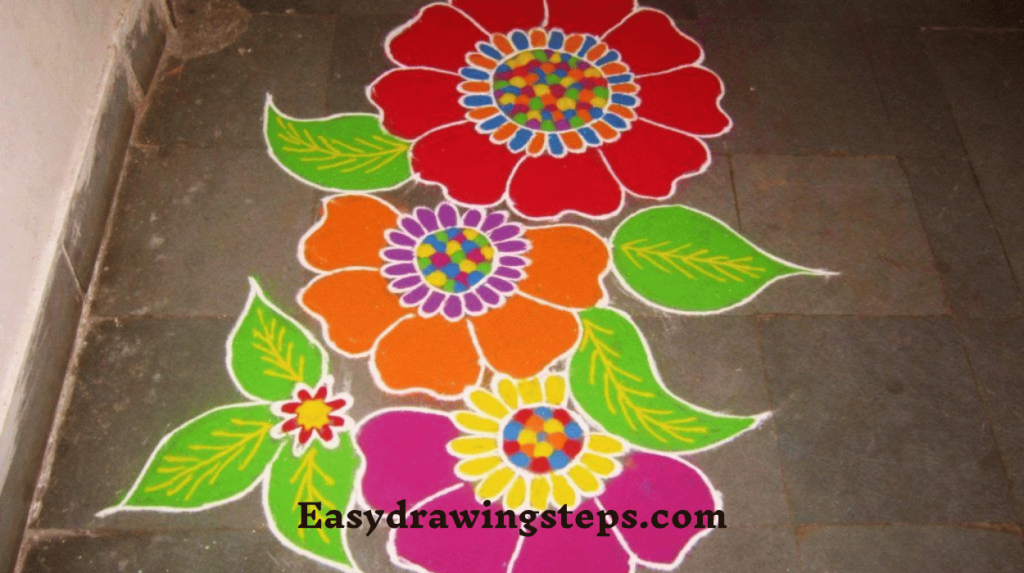Jaswand Rangoli : Rangoli, a traditional Indian art form, adds vibrant colors and beauty to festive occasions and celebrations. Among the various designs, Jaswand Rangoli is a popular choice, especially for its intricate and elegant appearance.
Jaswand, also known as Hibiscus, is a flower that is deeply revered in Indian culture. This guide will walk you through 10 easy steps to draw a Jaswand Rangoli, incorporating Jaswand flower designs to create stunning and intricate patterns.
Step 1: Gather Your Supplies
Before starting, make sure you have all the necessary supplies: colored rangoli powders, chalk or pencil for outlining, a sketchpad or the floor as your canvas, and a clean, dry cloth for corrections. For a Jaswand Rangoli, it’s helpful to have shades of red, yellow, green, and white, mirroring the colors of the Jaswand flower.

Step 2: Choose a Design
Start by choosing a Jaswand Rangoli design. Jaswand Rangoli designs often feature intricate patterns that mimic the shape of the Jaswand flower. You can find various designs online or create your own. The key is to focus on the flower’s petals and center, as these are the focal points of your Rangoli.
Also Read : 10 Easy Steps to Draw Vinayaka Drawing
Step 3: Outline the Design
Using chalk or a pencil, lightly outline the Jaswand Rangoli design on your chosen surface. Begin with a central point where the flower will be. From this central point, draw the outline of the flower’s petals radiating outward. Make sure the petals are symmetrical and evenly spaced to give a balanced look.
Step 4: Fill in the Base Colors
Once the outline is complete, start filling in the base colors. Jaswand flowers are typically red, so begin with red Rangoli powder to fill in the petals. Use a small, precise tool or your fingers to apply the powder within the outlined areas. For a more realistic effect, blend different shades of red to give depth and dimension to the petals.

Step 5: Add Petal Details
After filling in the base color, add details to the petals. Use white or yellow Rangoli powder to create highlights and enhance the texture of the flower. This will make the petals appear more lifelike and three-dimensional. Gently blend the colors where they meet to achieve a smooth gradient.
Step 6: Design the Flower Center
The center of the Jaswand flower is an essential part of the Rangoli. Typically, it is a deep yellow or orange. Carefully fill in the center with the chosen color, ensuring it contrasts well with the petals. You can use a fine-tipped tool to create small details and add depth to the center.
Also Read : 10 Easy Steps to Draw Lord Ganesha Drawing
Step 7: Add Leaves and Stems
To complement the Jaswand flower, add leaves and stems to your Rangoli design. Use green Rangoli powder to draw the leaves and stems around the flower. Ensure that the leaves are proportionate to the flower and add a touch of yellow or white to give them a realistic look.
Step 8: Incorporate Additional Patterns
Enhance your Jaswand Rangoli by adding additional patterns or motifs. Traditional Rangoli designs often include geometric patterns or smaller flowers around the main design. These additional elements can be filled with contrasting colors to create a vibrant and intricate design.
Also Read : 10 Steps to Draw Easy Ganpati Drawing
Step 9: Review and Touch Up
Once all the colors are applied, review your Rangoli design for any inconsistencies or areas that need touch-ups. Use a small brush or your fingers to correct any mistakes and blend colors where needed. Ensure that the design looks balanced and the colors are evenly distributed.
Step 10: Final Touches
Complete your Jaswand Rangoli by adding final touches. You can sprinkle some glitter or use decorative elements like flower petals to enhance the Rangoli. Make sure to keep the Rangoli clean and free from smudges to maintain its vibrant appearance.
Creating a Jaswand Rangoli is a beautiful way to celebrate traditions and showcase artistic skills. By following these 10 easy steps, you can craft a stunning Rangoli that captures the elegance of the Jaswand flower. From outlining the design to adding intricate details, each step is crucial in achieving a captivating and colorful Rangoli. Whether for a festival, celebration, or simply to add beauty to your home, the Jaswand Rangoli will surely leave a lasting impression.
Jaswand Rangoli FAQ
What is Jaswand Rangoli?
Jaswand Rangoli is a traditional Indian art form that uses colored powders to create intricate patterns and designs on the floor. The design specifically features the Jaswand flower, also known as Hibiscus, which is celebrated for its vibrant colors and significance in Indian culture. This type of Rangoli is often created during festivals and special occasions to add beauty and auspiciousness to the celebrations.
What colors are typically used in Jaswand Rangoli?
In Jaswand Rangoli, the primary colors used are red, yellow, green, and white. Red represents the color of the Jaswand flower petals, while yellow or orange is used for the flower’s center. Green is used for the leaves and stems, and white can be used for highlights and additional details. These colors are chosen to mimic the natural hues of the Jaswand flower and create a vibrant and visually appealing design.
How do I choose the right Jaswand Rangoli design?
When choosing a Jaswand Rangoli design, consider the complexity and size of the design based on your skill level and available space. You can select from various designs available online or create your own. Focus on designs that highlight the flower’s petals and center, as these are the key features. For beginners, simpler designs with fewer details may be easier to manage, while more intricate designs can be tackled by those with more experience.
Can I use materials other than Rangoli powder for Jaswand Rangoli?
While Rangoli powder is the traditional material used for creating Rangoli designs, you can experiment with other materials such as colored sand, flower petals, or even colored rice. These alternatives can add different textures and effects to your Jaswand Rangoli. However, Rangoli powder remains the most common choice due to its ease of use and vibrant colors.
How do I maintain and preserve my Jaswand Rangoli?
To maintain and preserve your Jaswand Rangoli, avoid disturbing the design and keep the area clean. If the Rangoli is placed outdoors, consider covering it to protect it from the elements. For indoor Rangoli, gently clean the surrounding area to prevent dust and dirt from smudging the design. If you want to keep the Rangoli for a longer time, you can photograph it as a keepsake before removing it.



1 thought on “10 Easy Steps to Draw Jaswand Rangoli”